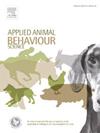新生山羊条件厌恶实验参数的建立
IF 2
2区 农林科学
Q1 AGRICULTURE, DAIRY & ANIMAL SCIENCE
引用次数: 0
摘要
条件场所厌恶(CPA)是一种用于研究动物情感反应的行为实验。动物通常习惯于在不同的地方经历不同的经历,因此根据它们对事件的记忆,它们被期望避开它们经历过最消极(或最不积极)经历的地方。这种方法已被用于评估农场动物疼痛的情感成分,但尚未应用于新生山羊。由于动物对不同环境的偏好可能受到多种环境因素的影响,我们的目标是评估1)侧面(左或右)和颜色(红、白、黄或蓝)是否影响儿童的偏好;2)基于儿童的探索和发声反应(用作压力的替代措施),儿童是否应该单独或成对地适应CPA测试装置。96只山羊(8只 ±4d只)随机分为两组(n = 24对)或单独(n = 48只),在一个三室的围栏(两个彩色的侧隔间由中间的中性隔间连接)中进行15分钟的适应试验。与黄色隔间相比,孩子们花在蓝色隔间的时间更长,但与白色或红色隔间相比,花在蓝色隔间的时间没有统计学差异。此外,无论隔间/颜色组合如何,与左侧相比,孩子们表现出对右侧隔间的偏好。单独测试时,孩子们发声的次数是两人测试时的五倍,去旁边隔间的次数减少了一半。我们建议,在当前研究中检查的颜色组合中,蓝色和白色似乎是未来CPA实验中使用的合适选择,但在实验设计中必须考虑侧面偏好。此外,建议让孩子们成对地而不是单独地适应CPA考试,以减轻压力,促进探索。需要进一步的工作来确认这里发现的偏倚是否在其他测试环境中(例如,条件反射后)仍然存在,并澄清测试条件反射的地方厌恶对山羊孩子个体的影响。本文章由计算机程序翻译,如有差异,请以英文原文为准。
Development of experimental parameters for conditioned place aversion testing in neonatal goat kids
Conditioned place aversion (CPA) is a behavioral assay used to investigate animals’ affective responses. Animals are typically conditioned to differing experiences in different places, whereupon they are expected to avoid the place where they experienced the most negative (or least positive) experience based on their memory of the events. This approach has been used to assess the affective component of pain in farm animals but has not yet been applied to neonatal goat kids. As animals’ preferences for different environments may be affected by several environmental factors, our objectives were to assess 1) whether side (left or right) and color (red, white, yellow, or blue) influenced kids' preferences and 2) whether kids should be acclimated to the CPA test apparatus alone or in pairs based on their exploratory and vocalization responses (used as proxy measures of stress). 96 goat kids (8 ± 4d) were randomly allocated to testing in pairs (n = 24 pairs) or alone (n = 48 kids) for a 15-minute acclimation test in a three-compartment pen (two colored side compartments linked by a middle neutral compartment). Kids spent more time in the blue compartment compared to yellow but showed no statistical difference in time spent in blue compared to white or red compartments. Additionally, kids displayed a preference for the right compartment compared to the left, regardless of compartment/color combination. When tested alone as compared to in pairs, kids vocalized five times more and halved their number of visits to side compartments. We suggest that of the color combinations examined in the current study, blue and white appear to be suitable choices for use in future CPA experiments, but side preference must be accounted for in experimental design. Further, acclimating kids to CPA tests in pairs, rather than alone, is recommended to reduce stress and promote exploration. Further work is needed to confirm whether the side bias found here persists in other testing contexts (e.g., after conditioning), and to clarify the impact of testing conditioned place aversion in individual goat kids.
求助全文
通过发布文献求助,成功后即可免费获取论文全文。
去求助
来源期刊

Applied Animal Behaviour Science
农林科学-行为科学
CiteScore
4.40
自引率
21.70%
发文量
191
审稿时长
18.1 weeks
期刊介绍:
This journal publishes relevant information on the behaviour of domesticated and utilized animals.
Topics covered include:
-Behaviour of farm, zoo and laboratory animals in relation to animal management and welfare
-Behaviour of companion animals in relation to behavioural problems, for example, in relation to the training of dogs for different purposes, in relation to behavioural problems
-Studies of the behaviour of wild animals when these studies are relevant from an applied perspective, for example in relation to wildlife management, pest management or nature conservation
-Methodological studies within relevant fields
The principal subjects are farm, companion and laboratory animals, including, of course, poultry. The journal also deals with the following animal subjects:
-Those involved in any farming system, e.g. deer, rabbits and fur-bearing animals
-Those in ANY form of confinement, e.g. zoos, safari parks and other forms of display
-Feral animals, and any animal species which impinge on farming operations, e.g. as causes of loss or damage
-Species used for hunting, recreation etc. may also be considered as acceptable subjects in some instances
-Laboratory animals, if the material relates to their behavioural requirements
 求助内容:
求助内容: 应助结果提醒方式:
应助结果提醒方式:


